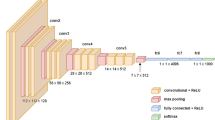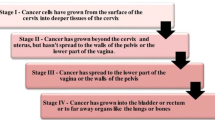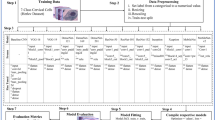Abstract
Early detection, early diagnosis and classification of the cancer type facilitates faster disease management of patients. Cervical cancer is fourth most pervasive cancer type which affects life of many people worldwide. The intent of this study is to automate cancer diagnosis and classification through deep learning techniques to ensure patients health condition progress timely. For this research, Herlev dataset was utilized which contains 917 benchmarked pap smear cells of cervical with 26 attributes and two target variables for training and testing phase. We have adopted combination of convolutional network with variational autoencoder for data classification. The usage of variational autoencoder reduces the dimensionality of data for further processing with involvement of softmax layer for training. The results have been obtained over 917 cancerous image type pap smear cells, where 70% (642) allocated for training and remaining 30% (275) considered for test data set. The proposed architecture achieved variational accuracy of 99.2% with 2*2 filter size and 99.4% with 3*3 filter size using different epochs. The proposed hybrid variational convolutional autoencoder approach applied first time for cervical cancer diagnosis and performed better than traditional machine learning methods.









Similar content being viewed by others
References
Adem K, Kilicarslan S, Cömert O (2019) Classification and diagnosis of cervical cancer with softmax classification with stacked autoencoder. Expert Syst Appl 115:557–564
Almubarak HA, Stanley RJ, Long R, Antani S, Thoma G, Zuna R, Frazier SR (2017) Convolutional neural network based localized classification of uterine cervical cancer digital histology images. Procedia Comput Sci 114:281–287
Chen W, Gou S, Wang X, Li X, Jiao L (2018) Classification of PolSAR images using multilayer autoencoders and a self-paced learning approach. Remote Sens 10(1):1–17. https://doi.org/10.3390/rs10010110
Elayaraja P, Suganthi M (2018) Automatic approach for cervical cancer detection and segmentation using neural network classifier. Asian Pac J Cancer Prev: APJCP 19(12):3571
Ferlay J, Soerjomataram I, Ervik M, Forman D, Bray F, Dixit R et al (2012) GLOBOCAN 2012, Cancer Incidence and Mortality Worldwide in 2012. International Agency for Research on Cancer, Lyon
Fukushima K, Neocognitron (2007) Scholarpedia 19(1):1717
Goodman A (2000) Abnormal genital tract bleeding. Clin Cornerstone 3(1):25–35. https://doi.org/10.1016/S1098-3597(00)90019-X
Ho SH, Jee SH, Lee JE, Park JS (2004) Analysis on risk factors for cervical cancer using induction technique. Expert Syst Appl 27(1):97–105. https://doi.org/10.1016/j.eswa.2003.12.005
Institute for Health Metrics and Evaluation (2011) The challenge ahead: Progress in breast and cervical cancer. institute of health metrics and evaluation. Institute of Health Metrics and Evaluation
Jantzen J, Dounias G. Analysis of pap-smear image data. In Nature-Inspired Smart Information Systems 2nd Annual Symposium 2006. NiSIS
Krizhevsky A, Sutskever I, Hinton GE (2012) Imagenet classification with deep convolutional neural networks. In: Advances in neural information processing systems pp 1097–1105
Kusy M, Obrzut B, Kluska J (2013) Application of gene expression programming and neural networks to predict adverse events of radical hysterectomy in cervical cancer patients. Med Biol Eng Comput 51(12):1357–1365
Obukhova NA, Motyko AA, Kang U, Bae SJ, Lee DS (2017) Automated image analysis in multispectral system for cervical cancer diagnostic. In: Open Innovations Association (FRUCT), 20th Conference of (pp. 345–351), IEEE, Piscataway
Richhariya B, Tanveer M (2018) EEG signal classification using universum support vector machine. Expert Syst Appl 15:169–182
Shao YH, Zhang CH, Wang XB, Deng NY (2011) Improvements on twin support vector machines. IEEE Trans Neural Netw 22(6):962–8
Sun G, Li S, Cao Y, Lang F (2017) Cervical cancer diagnosis based on random forest. Int J Performabil Eng 13:446–457
Verma A, Verma S, Vashist S, Attri S, Singhal A (2017) A study on cervical cancer screening in symptomatic women using Pap smear in a tertiary care hospital in rural area of Himachal Pradesh, India. Middle East Fertil Soc J 22(1):39–42
Wu W, Zhou H (2017) Data-driven diagnosis of cervical cancer with support vector machine-based approaches. IEEE Access 5:25189–25195
Yamal JM, Guillaud M, Atkinson EN, Follen M, MacAulay C, Cantor SB, Cox DD (2015) Prediction using hierarchical data: Applications for automated detection of cervical cancer. Stat Anal Data Mining: ASA Data Sci J 8(2):65–74
Zhang L, Lu L, Nogues I, Summers RM, Liu S, Yao J, Deeppap (2017) Deep convolutional networks for cervical cell classification. IEEE J Biomed Health Inform 21(6):1633–1643
Acknowledgements
VHCA received support from the Brazilian National Council for Research and Development (CNPq, Grant# 304315/2017-6 and #430274/2018-1). Joel JPC Rodrigues received supported by FCT/MCTES through national funds and when applicable co-funded EU funds under the Project UIDB/EEA/50008/2020; and by Brazilian National Council for Research and Development (CNPq) via Grant No. 309335/2017-5.
Author information
Authors and Affiliations
Corresponding author
Ethics declarations
Conflict of interest
The authors acknowledge that they have no competing and conflict of interest.
Additional information
Publisher’s note
Springer Nature remains neutral with regard to jurisdictional claims in published maps and institutional affiliations.
Rights and permissions
About this article
Cite this article
Khamparia, A., Gupta, D., Rodrigues, J.J.P.C. et al. DCAVN: Cervical cancer prediction and classification using deep convolutional and variational autoencoder network. Multimed Tools Appl 80, 30399–30415 (2021). https://doi.org/10.1007/s11042-020-09607-w
Received:
Revised:
Accepted:
Published:
Issue Date:
DOI: https://doi.org/10.1007/s11042-020-09607-w




